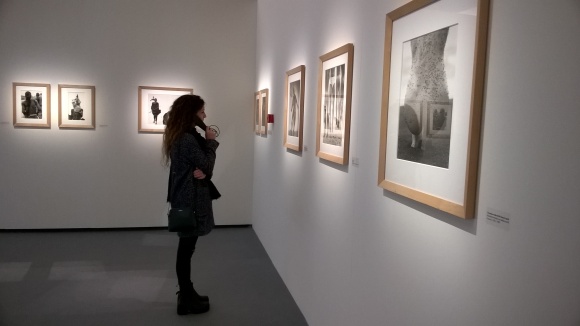Time for a sweet escape in my home town, and my architect-to-be sister brought me to Palazzo della Ragione (“Palace of Reason”) in the centre, an antique space now recycled, yet not renovate, to show photography exhibitions. Now on a retrospective on Herb Ritts (1952-2002), whose black and white potraits of models and actors of the Eighties and Nineties have come to be part part of popoular culture.
Born in Los Angeles, Herb, who held a degree in Economics, started his career as a photographer quite randomly. In 1978 he took pictures of his friend Richard Gere, then a young and unknown actor, while waiting for their car to be fixed in the middle of the hot Californian countryside. Who could have imagined that this would have been the beginning of an artistic journey that would make him work with many of the most famous folks in the Western star-system? He had an innate sense for composition, but also studied Greek statuary and the works of Bruce Weber and Man Ray among others, often referencing them in his pics.

The exhibition reconstructs his whole career, dividing it in three main phases or themes of interest: the body as cult, Ritt’s trip to Kenya in 1994 and finally portaits of famous personalities. His sense of sacred emanates from the naked bodies displayed in the first section as something almost moving. He was keen on natural light and detailed every little feature of an image to make a body look perfect, timeless, god-like. Observing his works, you can experience a sort of synesthesia, because through your sight you can feel the perfect smoothness of the model’s satin skin, the interplay between the heat of the sun and the soothing shadow on the body, the power of this machine that our physicality is. His collaborations with fashion houses such as Versace or Calvin Klein, just to cite a couple, helped defining the body as an idol in the post-modern era, where fitness and fashion were becoming increasingly popoular. Yet I find there is some kind of fragility in his compositions, maybe a Sehnsucht for a perfection that doesn’t exist in real life; thus these beautiful photographies become mementoes for the natural decay none of us can escape.
The group of pictures on the Maasai popoulation are maybe separate, an interlude between the many glamorous collaborations this photographer experienced, yet they present the same hieratic power, the same pursuit of a sacred dimension. I don’t know if he would have accepted it, however the characterisation of this trip as his “African period” by the curators reflect the old Western conceptions on Africa as an indifferentiated dark area where mysterious and unintelligible are the key elements. This reiterates a bias that is completely out of date, as discussed in a conference by artist Hassan Musa that I reviewed here.


The potraits section is both fun and melancholic. Herb’s aim when taking a portrait was to capture the inside, making visible the personality of the sitter. The use of black and white in this instance is very helpful; it reduces the composition to simplicity and emphasises shadows and features. The resulting images are incredibly powerful and evocative not only of the model’s character, but also of the photographer’s sensibility. I should remark here that the choice of black and white obviously makes an impact on how we behold and compare photographs and reality. Herb’s work being situated in the second half of the XIX century was very influential in shaping the perception of black and white as “pure” and “essential” and, to a certain extent, more apt to represent beauty.

The exhibition is overall well structured and contains many valuable gelatine silver prints that were all produced while Herb was still alive. The explicative panels are interesting and smartly disposed. They give information without too much distracting the viewer from the main experience of seeing. I didn’t find the audioguide, which is included in the price, particularly useful.

Herb Ritts – In equilibrio (“Herb Ritts – In balance”) runs until 5th June 2016. Entry 12€, 10€ concessions.
Useful links:
Official page: http://www.palazzodellaragionefotografia.it/portfolio/dal-20-febbraio-al-5-giugno-2016herb-rittsherb-ritts


















